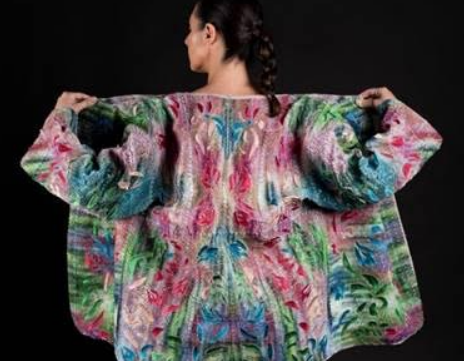Stratasys PolyJet Used for Direct-to-Textile 3D Printed Clothing
As a longtime industry leader in 3D printing, Stratasys is usually associated with quality technology, accompanied by forward-thinking users bringing us a wide range of complex projects. Associated with everything from applications in aerospace to electronics, we have also seen a fascinating variety of innovations within the art and fashion world via Stratasys 3D printers—especially with the recent trend in direct to textile fabrication techniques.
Now, Stratasys is working with two new fashion designers, Julia Koerner and Ganit Goldstein. This collaboration follows on the heels not only of their unveiling the new ability to 3D print onto fabric, but also new examples of such techniques via other designers like threeASFOUR and Travis Fitch. The announcement at New York Fashion Week last year and following haute couture works were apparently just a foreshadowing of the innovative work to come.
As 3D printing continues to offer designers greater freedom in creating complex geometries with fabric, the European Union has funded a research project called Re-FREAM, an effort uniting designers, engineers, and scientists as they combine 3D printing and fashion.
To begin, Koerner has just launched her ARID collection at the ARS Electronica Festival, being held from September 9 to 13 in Linz, Austria as a virtual event. Like so many 3D printed projects making an impact in research, Koerner’s designs are inspired by nature, as well as promoting technology that is more sustainable, decreases energy usage, and also results in substantially less material waste.
The collection features 38 different parts, forming a modular design that can be fitted into an entire dress or “cascade into a number of different looks and combinations,” according to the press release sent from Stratasys to 3DPrint.com. Koerner relies on Stratasys PolyJet Technology for 3D printing her colorful, shimmering fashion designs—meant to be appealing in their obvious glamour, but also comfort.
Even better, the designs allow for consumer-specific customizations made possible due to 3D scans which are made of the wearer. The pieces are not sewn, but rather joined together with 3D printed connectors (a first in textile assemblies).
Goldstein’s fashion shows the versatility of this collaborative research as she combined craft techniques with 3D printing for a kimono-inspired gown. After a year in Japan studying Asian design, Goldstein displays her knowledge of interweaving and craft embroidery and textile painting beautifully, also using the ikat coloring method, embraced in Japanese design. Goldstein’s design is also based on a 3D scan of the wearer, resulting in a direct-to-textile, multi-color print.
“In fashion, it’s important that we continually optimize and evolve to introduce new design forms,” says Goldstein. “During the past year, I experimented with numerous different fabrics and technologies to incorporate 3D printing within textiles. Achieving this milestone takes us away from 2D design and opens up a world of wearable 3D garments.
“Looking at the fashion world today, I want to introduce a new way of manufacturing – moving away from mass production to customized design,” says Goldstein. “3D printing has always offered the potential to personalize design in ways not possible before, but to truly create a new way to manufacture requires a new kind of textile. My goal is to create a new hybrid world of crafts and multi-color 3D printing – connecting past, new and future techniques to evolve fashion design.”
Koerner and Goldstein both offer impressive—and inspiring—evidence that Re-FREAM’s ambitious goal of digitizing workflow is possible from beginning to end in a design project. Although still in the testing stages, direct-to-textile technology offers further advantages in digital fabrication with on-demand production as well as the opportunity for mass customization.
[Source / Images: Stratasys]Subscribe to Our Email Newsletter
Stay up-to-date on all the latest news from the 3D printing industry and receive information and offers from third party vendors.
Print Services
You May Also Like
3D Printing Grows to $15.9B in 2024 Amid Shifting Industry Dynamics
The global additive manufacturing (AM) market reached $15.9 billion in calendar year 2024, according to “Q4 2024 3DP/AM Market Data and Forecast” from Additive Manufacturing Research (AM Research). Despite a...
Low-cost “Suzy” Polymer Powder 3D Printer is Faster and Cheaper than Past Models
Polish laser powder bed fusion (LPBF) firm Sinterit has released a follow-up to its predecessors, Lisa and Nils, called Suzy, a $19,490 printer equipped with a 30W fiber diode laser....
BellaSeno’s 3D Printed Breast Implants Keep Shape with 87% Fat Volume, Avoids Silicone Risks
At a medical conference in Austin this week, a new kind of breast implant took center stage. It is not made from silicone but from a 3D printed, fully resorbable...
Australia’s Untapped Potential as a Disruptive Innovator: SPEE3D CTO Steven Camilleri Explains Why He Wants to Make Stuff There
When I first met Steven Camilleri in 2023, the CTO of additive manufacturing (AM) OEM SPEE3D shared a quote with me from Clayton Christensen, the late Harvard professor who popularized...






























